Content Menu
● Introduction
● Types of Aluminum Extrusion Profiles
>> Standard Profiles
>> Custom Profiles
>> Specialty Profiles
● The Aluminum Extrusion Process
>> Overview of the Extrusion Process
>> Equipment Used in Aluminum Extrusion
● Applications of Aluminum Extrusion Profiles
>> Construction Industry
>> Automotive Industry
>> Electronics Industry
● Benefits of Using Aluminum Extrusion
>> Design Flexibility
>> Cost-Effectiveness
>> Sustainability
● Conclusion
● Related Questions
>> 1. What are the main advantages of using aluminum extrusion in manufacturing?
>> 2. How does the aluminum extrusion process differ from other manufacturing methods?
>> 3. Can aluminum extrusion profiles be customized for specific applications?
>> 4. What industries benefit the most from aluminum extrusion?
>> 5. Is aluminum extrusion an environmentally friendly manufacturing process?
Introduction
Aluminum extrusion is a manufacturing process that transforms aluminum alloy into specific shapes and profiles. This process is widely used in various industries due to its versatility, efficiency, and cost-effectiveness. Understanding how the aluminum extrusion process works and its benefits can help businesses and individuals make informed decisions about using aluminum in their projects. This article will delve into the intricacies of the aluminum extrusion process, explore the different types of aluminum extrusion profiles, and highlight the numerous advantages of this manufacturing technique.

Types of Aluminum Extrusion Profiles
Aluminum extrusion profiles come in various shapes and sizes, each designed for specific applications. The most common types of aluminum extrusion profiles include:
Standard Profiles
Standard profiles are pre-defined shapes that are widely used across different industries. These include:
- Angles: L-shaped profiles that provide structural support in various applications.
- Channels: U-shaped profiles often used in framing and support structures.
- Tubes: Hollow cylindrical profiles that are used in a variety of applications, from furniture to automotive parts.
These standard profiles are readily available and can be easily sourced, making them a popular choice for many manufacturers.
Custom Profiles
Custom aluminum extrusions are designed to meet specific requirements that standard profiles cannot fulfill. This involves working closely with engineers and designers to create unique shapes tailored to particular applications. Custom profiles can be used in specialized machinery, architectural elements, and other unique projects where standard profiles may not suffice.
Specialty Profiles
Specialty profiles are designed for niche markets and specific applications. These profiles may include complex shapes that serve unique functions, such as heat sinks in electronics or intricate designs for decorative purposes. Specialty profiles often require advanced design and engineering capabilities, making them a valuable asset in high-tech industries.
The Aluminum Extrusion Process
The aluminum extrusion process involves several key steps that transform raw aluminum into finished products. Understanding these steps is crucial for appreciating the efficiency and effectiveness of aluminum extrusion.
Overview of the Extrusion Process
1. Billet Preparation: The process begins with the preparation of aluminum billets, which are cylindrical blocks of aluminum alloy. These billets are heated to a specific temperature, making the aluminum malleable and easier to shape.
2. Extrusion: Once the billets are heated, they are placed in an extrusion press. A ram pushes the heated billet through a die, which shapes the aluminum into the desired profile. The die is a crucial component, as it determines the final shape of the extruded aluminum.
3. Cooling: After the aluminum has been extruded, it is cooled to solidify the shape. This can be done using air cooling or water quenching, depending on the specific requirements of the profile.
4. Cutting: Once cooled, the extruded aluminum is cut to the desired length. This step ensures that the profiles are ready for further processing or assembly.
5. Finishing: The final step involves surface finishing processes such as anodizing, painting, or polishing. These finishes enhance the appearance of the aluminum and provide additional protection against corrosion and wear.

Equipment Used in Aluminum Extrusion
The aluminum extrusion process relies on specialized equipment to ensure precision and efficiency. Key equipment includes:
- Extrusion Press: This machine applies the necessary force to push the heated billet through the die.
- Dies: Custom-made dies are essential for shaping the aluminum into specific profiles. The design of the die directly impacts the quality and accuracy of the extruded product.
- Cooling Systems: These systems are used to control the cooling process, ensuring that the aluminum solidifies correctly and maintains its shape.
Applications of Aluminum Extrusion Profiles
Aluminum extrusion profiles are utilized in a wide range of industries due to their versatility and strength. Some of the key applications include:
Construction Industry
In the construction industry, aluminum extrusion profiles are used for structural components, window frames, and curtain walls. Their lightweight nature and resistance to corrosion make them ideal for both residential and commercial buildings. Additionally, aluminum profiles can be easily customized to fit specific architectural designs.
Automotive Industry
The automotive industry benefits significantly from aluminum extrusion due to the material's lightweight properties. Aluminum extrusions are used in various vehicle components, including chassis, bumpers, and heat exchangers. By using aluminum, manufacturers can reduce the overall weight of vehicles, leading to improved fuel efficiency and performance.
Electronics Industry
In the electronics industry, aluminum extrusion profiles are commonly used for housing and structural supports for devices. The excellent thermal conductivity of aluminum makes it an ideal choice for heat sinks, which help dissipate heat from electronic components, ensuring optimal performance and longevity.
Benefits of Using Aluminum Extrusion
The aluminum extrusion process offers numerous advantages that make it a preferred choice for manufacturers across various industries. Some of the key benefits include:
Design Flexibility
One of the most significant advantages of aluminum extrusion is its design flexibility. The process allows for the creation of complex shapes and profiles that can be tailored to meet specific requirements. This flexibility enables designers to innovate and create unique products that stand out in the market.
Cost-Effectiveness
Aluminum extrusion is a cost-effective manufacturing method, especially for large production runs. The efficiency of the extrusion process reduces material waste and minimizes labor costs. Additionally, the lightweight nature of aluminum can lead to lower shipping costs, further enhancing its cost-effectiveness.
Sustainability
Aluminum is a highly sustainable material, as it is 100% recyclable without losing its properties. The aluminum extrusion process can incorporate recycled aluminum, reducing the environmental impact of production. Furthermore, aluminum's durability and resistance to corrosion contribute to the longevity of products, minimizing the need for replacements and reducing waste.
Conclusion
The aluminum extrusion process is a vital manufacturing technique that offers numerous benefits across various industries. From its ability to create diverse profiles to its cost-effectiveness and sustainability, aluminum extrusion is a preferred choice for many applications. Understanding how the process works and the types of profiles available can help businesses and individuals make informed decisions about incorporating aluminum into their projects.

Related Questions
1. What are the main advantages of using aluminum extrusion in manufacturing?
Aluminum extrusion offers design flexibility, cost-effectiveness, and sustainability, making it an ideal choice for various manufacturing applications.
2. How does the aluminum extrusion process differ from other manufacturing methods?
Unlike other methods, aluminum extrusion involves pushing heated aluminum through a die to create specific shapes, allowing for greater design flexibility and reduced material waste.
3. Can aluminum extrusion profiles be customized for specific applications?
Yes, custom aluminum extrusion profiles can be designed to meet specific requirements, making them suitable for a wide range of applications.
4. What industries benefit the most from aluminum extrusion?
The construction, automotive, and electronics industries are among the primary sectors that benefit from aluminum extrusion due to its versatility and strength.
5. Is aluminum extrusion an environmentally friendly manufacturing process?
Yes, aluminum is highly recyclable, and the extrusion process can incorporate recycled materials, making it a sustainable choice for manufacturing.






















